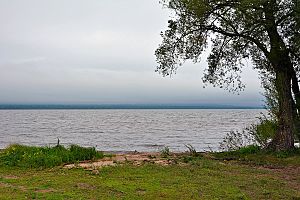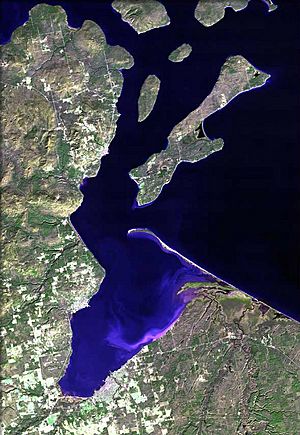Chequamegon Bay facts for kids
Chequamegon Bay (say it: shə-WAH-mə-gən) is a large inlet, or arm, of Lake Superior. It's located in the very northern part of Wisconsin, touching Ashland and Bayfield counties.
Contents
History of Chequamegon Bay
Long ago, in the mid-1600s, a Native American village called Chequamegon grew here. People from the Petun, Huron, and Ottawa tribes settled there. They were looking for a safe place after wars and invasions from the east. Later, Ojibwe people also came to this area to trade.
The end of Chequamegon Bay is known as the first place in Wisconsin where Europeans lived. In 1658, two French fur traders, Médard des Groseilliers and Pierre-Esprit Radisson, built a small hut on the west side of the bay. Other traders lived here between 1660 and 1663.
In 1661, Father René Menard, a Jesuit missionary, visited the traders. In 1665, Father Claude-Jean Allouez built a mission house nearby. His helper, Father Jacques Marquette, stayed there for two years starting in 1669.
In 1693, Pierre LeSueur built a fort on the largest island in the bay, which is now called Madeline Island. The French left this fort before the year 1700.
In 1718, another French fort was built on Madeline Island. This fort was a place for fur trading and exploring for copper. It was called La Pointe and had French soldiers until 1759, during the Seven Years' War (also known as the French and Indian War in North America).
The first English trader to reach this distant post was Alexander Henry the elder. His French business partner, Jean Baptiste Cadotte, started a lasting trading post there.
In 1818, two traders from Massachusetts, Lyman and Truman Warren, arrived. They married daughters of Michel Cadotte, a fur trader and Jean Baptiste's son. Michel Cadotte gave his trading business to the Warren brothers. They became the main American fur traders in the area. Truman Warren died early, but Lyman lived in La Pointe until he passed away in 1847.
During the early 1800s, a village grew around the trading post. It was home to retired voyageurs and fur traders. John Jacob Astor's American Fur Company also had a trading post here for many years. The first Protestant mission in Wisconsin was started here in 1831.
Why is it called Chequamegon?

The name Chequamegon comes from the Ojibwe language. It comes from the word Zhaagawaamikong or jagawamikiong. This means "a sand bar place," or "a strip of land running into a body of water."
Geography of Chequamegon Bay
Chequamegon Bay is mostly protected by Chequamegon Point and Long Island. To the east is the Bad River Indian Reservation. The city of Ashland, Wisconsin is to the south of the bay, and Washburn, Wisconsin is to its north.
The huge 850,000 acres (3,440 km2) Chequamegon–Nicolet National Forest is mostly to the south and west of the bay. The Ashland Harbor Breakwater lighthouse, also known as Ashland Breakwater Lighthouse, is a working lighthouse located in the bay.
See also
 In Spanish: Bahía Chequamegon para niños
In Spanish: Bahía Chequamegon para niños


